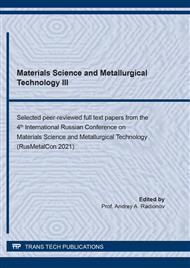[1]
S.L. Burakov, A.I. Veinik, N.P. Dubinin, Chill Casting, Mashinostroenie, Moscow, (1980).
Google Scholar
[2]
K.N. Gavarieva, L.A. Simonova, D.L. Pankratov, R.V. Gavariev, Development of expert systems for modeling of technological process of pressure casting on the basis of artificial intelligence, IOP Conf. Series: Materials Science and Engineering. 240 (2017) 012019.
DOI: 10.1088/1757-899x/240/1/012019
Google Scholar
[3]
S. Juan, G. Feng, G. Xiaobo, F. Haiquan, Study on solid-solution interaction and existing forms of alloying elements in Mg–Al–Zn-Gd alloy, Journal of Alloys and Compounds. 854 (2021) 156209.
DOI: 10.1016/j.jallcom.2020.156209
Google Scholar
[4]
L.D.K. Catherine, D.A. Hamid, Mechanical properties and machinability of magnesium alloy AZ31 and AZ91 – A comparative review, IOP Conf. Series: Materials Science and Engineering. 1062 (2021) 012054.
DOI: 10.1088/1757-899x/1062/1/012054
Google Scholar
[5]
O. Trudonoshyn, P. Randelzhofer, C. Körner, Heat treatment of high-pressure die casting Al-Mg-Si-Mn-Zn alloys, Journal of Alloys and Compounds. 872 (2021) 159692.
DOI: 10.1016/j.jallcom.2021.159692
Google Scholar
[6]
V.N. Gilman, A.I. Faskhutdinov, I.P. Balabanov, Increase effectiveness of shaving by using wear-resistant coatings and preliminary modeling cutting, Solid State Phenomena. 299 (2020) 839-844.
DOI: 10.4028/www.scientific.net/ssp.299.839
Google Scholar
[7]
K.N. Gavarieva, L.A. Simonova, D.L. Pankratov, V.G. Shibakov, R.V. Gavariev, Application of multi-agent system for control of parameters of precision stamping process of bevel gears, IOP Conference Series: Materials Science and Engineering. 412 (2018) 012020.
DOI: 10.1088/1757-899x/412/1/012020
Google Scholar
[8]
R.V. Gavariev, I.A. Savin, I.O. Leushin, To the question of casting alloys of non-ferrous metals in the metal mold, Materials Science Forum. 946 (2019) 631-635.
DOI: 10.4028/www.scientific.net/msf.946.631
Google Scholar
[9]
D.L. Pankratov, R.V. Gavariev, Improving the quality of castings made of non-ferrous metal alloys when casting in metal molds, IOP Conf. Series: Materials Science and Engineering. 570 (2019) 012072.
DOI: 10.1088/1757-899x/570/1/012072
Google Scholar
[10]
R.V. Gavariev, I.A. Savin, E.N. Soldatkina, Choice of protective coating of metal molds for casting non-ferrous alloys, Solid State Phenomena. 299 (2020) 867-871.
DOI: 10.4028/www.scientific.net/ssp.299.867
Google Scholar
[11]
N.N. Safronov, L.B. Mingaleeva, I.A. Savin, Optimization of charge material composition in shs process with ferrosilide fabrication from gaseous wastes of metallurgical production, Chernye Metally. 2 (2018) 53-59.
Google Scholar
[12]
A.V. Shaparev, I.A. Savin, Influence of the state of the contact surfaces on the formation of the joint of steel and brass during cold cladding, Solid State Phenomena. 284 (2018) 319-325.
DOI: 10.4028/www.scientific.net/ssp.284.319
Google Scholar
[13]
I.A. Savin, M. Akhmedeev, Connection of the steel pipes having a polymeric covering on internal and external surfaces, Solid State Phenomena. 299 (2020) 766-771.
DOI: 10.4028/www.scientific.net/ssp.299.766
Google Scholar
[14]
I.P. Balabanov, V.N. Gilman, T.S. Timofeeva, A.I. Faskhutdinov, Modeling of the cutting edge rounding influence on the tool life in processing a gear wheel by the Power Skiving method, International Journal of Engineering and Technology (UAE). 7(4) (2018) 71-73.
DOI: 10.14419/ijet.v7i4.7.20386
Google Scholar
[15]
V.N. Gilman, I.P. Balabanov, A.I. Faskhutdinov, Improving the efficiency of shaving through the use of wear-resistant coatings, IOP Conference Series: Materials Science and Engineering. 570 (2019) 012024.
DOI: 10.1088/1757-899x/570/1/012024
Google Scholar
[16]
A.V. Shaparev, I.A. Savin, Calculation of joint plastic deformation to form metal compound in cold condition, Solid State Phenomena. 265 (2017) 313-318.
DOI: 10.4028/www.scientific.net/ssp.265.313
Google Scholar
[17]
I.J. Polmear, Magnesium alloys and applications, Materials Science and Technology (United Kingdom). 10(1) (1994) 1-16.
Google Scholar
[18]
X.K. Li, Z.M. Zhang, Y.L. Zhao, Research progress and prospect of deformed magnesium alloys, Thermal Processing Technology. 24 (2011) 54.
Google Scholar
[19]
R.V. Gavariev, K.N. Gavarieva, on the issue of heat balance of molds for injection molding of non-ferrous metal alloys, IOP Conference Series: Materials Science and Engineering. 969(1) (2020) 012069.
DOI: 10.1088/1757-899x/969/1/012069
Google Scholar
[20]
R.V. Gavariev, K.N. Gavarieva, E.N. Soldatkina, features of design of chill molds for casting of non-ferrous metal, IOP Conference Series: Materials Science and Engineering. 969(1) (2020) 012068.
DOI: 10.1088/1757-899x/969/1/012068
Google Scholar
[21]
D.L. Pankratov, R.V. Gavariev, To the question of automation of the injection molding process, IOP Conference Series: Materials Science and Engineering. 915(1) (2020) 012043.
DOI: 10.1088/1757-899x/915/1/012043
Google Scholar
[22]
A.V. Shaparev, I.A. Savin, S.N. Ptichkin, Application of the Polymeric Material RIMAMID for Production of Machine Parts, IOP Conf. Series: Materials Science and Engineering. 969 (2020) 012021.
DOI: 10.1088/1757-899x/969/1/012021
Google Scholar
[23]
A.V. Shaparev, I.A. Savin, Calculation of the amount of the reduction required for the formation of compound layers during cold rolling of bimetals, Materials Science Forum. 870 (2016) 328-333.
DOI: 10.4028/www.scientific.net/msf.870.328
Google Scholar
[24]
A.V. Shaparev, Investigation of the effect of oxygen content in the auxiliary process gas on the quality and speed of laser cutting of steel sheets, Solid State Phenomena. 299 (2020) 457-461.
DOI: 10.4028/www.scientific.net/ssp.299.457
Google Scholar
[25]
Yu. N. Mansurov, A. A. Aksenov, V. P. Reva, Influence of the chill-mold casting process on the structure and properties of aluminum alloys with eutectic constituents, Tsvetnye Metally. 5 (2018) 77-81.
DOI: 10.17580/tsm.2018.05.11
Google Scholar
[26]
I.P. Kleinbug, L.M. Zheleznyak, S.I. Parshakov, E.N. Belonosova, Direct chill mold of original design for the continuous casting of complex-alloyed brasses and bronzes, Metallurgist. 59 (2015) 431-434.
DOI: 10.1007/s11015-015-0122-5
Google Scholar


